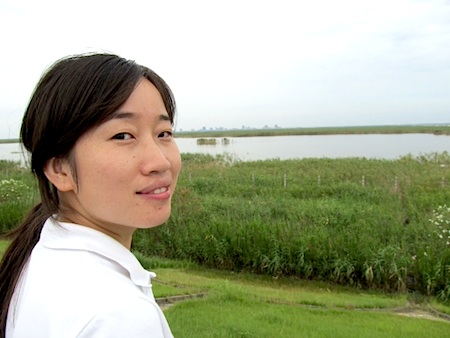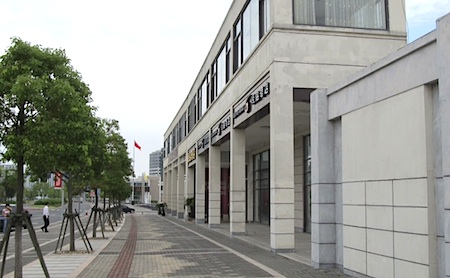LINGANG PORT CITY: Shanghai, China — Dishui Lake, constructed where the Yangtze River meets the East China Sea, is a perfectly circular manmade lake that was meant to put people in close proximity to fresh water.
The Nanhui Dongtan Wildlife Sanctuary, which lies on Dishui Lake’s eastern bank, is a 122.5-square-kilometer (47-square-mile) expanse of tall grasses and shallow, rain-fed ponds that also tests the lure of fresh water; in this case, to recruit great flocks of migratory birds. (That’s Yong Yi, a 33-year-old environmental scientist with WWF in Shanghai, who helped establish the reserve, in the pix above.)
From 2003 to 2005, both the lake and the sanctuary were constructed from silt and mud, carried downstream by the Yangtze and captured with long rock and concrete groins that engineers extended into the river’s mouth. Shanghai’s planning officials envisioned using the new ground to build a seaside district — Lingang Port City — that was intended to attract thousands of businesses and 400,000 residents by 2020; 800,000 residents by 2050.
The idea for this new borough was to reduce crowding, build contemporary commerce centers, and encourage lower population densities in Shanghai, a city of 23 million that is tallying 1 million additional residents every two years. If Shanghai were an American state, only California and Texas have more people.
The enterprise hasn’t quite worked out the way planners in Shanghai’s city government envisioned, however. For the time being, the wildlife sanctuary has been much more successful in attracting winged residents than neighboring Lingang Port City and its lake has been in recruiting businesses and human residents — yet. (See pix at bottom.)
Shanghai city managers know how to build a 21st-century city, and they are doing so with a clear focus on environmental values and energy efficiency, in addition to improving the quality of the water supply and expanding the size and number of parks and open spaces.
Better City, Better Life
Last year, Shanghai hosted a World Expo with the green-oriented theme: “Better city, better life.†Among the innovations promoted was Shanghai’s ongoing program to establish new and planned residential and business districts outside the core central city.
Lingang Port City was one such example, featuring big runs of green space, lots of clean water on display in canals and ponds, and countless new energy-efficient homes and offices. All of these new districts will be tied to the central city and to each other via Shanghai’s clean, fast, and steadily expanding subway system, which now consists of 11 lines, 267 stations, and 410 kilometers (255 miles) of track.
In 2002, Shanghai opened a Maglev train line from the downtown area to Pudong Airport. The train, which operates on powerful magnets that lift the cars onto a thin cushion of air, travels 431 kilometers an hour (267 miles per hour) and makes the trip in less than 7 minutes — 40 minutes less than in a taxi.
The Urban Land Institute, based in Washington, D.C. and one of the premier U.S. urban planning and development research organizations, reviewed Shanghai’s master plan in 2006 and declared: “No other city in history has attempted to tackle its urban issues with such a comprehensive program of public improvements and new-town development at its periphery.â€
Dishui Lake, the centerpiece of the Lingang Port City district, was intended as a showcase of the city’s master plan. With a diameter spanning 2.5 kilometers (1.5 miles) and a surface area of 5 square kilometers (2 square miles), Dishui has three sizable, grass-covered peninsulas that serve as green open space. From a birds-eye view, the peninsulas resemble continents and the lake — round as a dime and about 60 kilometers (37 miles) to the south of Shanghai’s high-rise central core — looks very much like a replica of Planet Earth. On its northern and western banks, the lake is surrounded by a constellation of new residential and office towers, the mostly uninhabited dark stars of Lingang Port City.
On the lake’s southern and eastern flank, though, lies the great expanse of freshwater ponds and grass reclaimed from the Yangtze estuary that is, for the time being, much more successful in attracting wild residents.
Big Water Cleanup
Though people have yet to show up in droves, filthy water is not one of the district’s impediments. Since 1995, Shanghai has spent $US 8.1 billion (RMB 50.3 billion) to construct a network of 52 sewage plants that now treat nearly 80 percent of the city’s wastewater, according to the Shanghai Municipal Oceanic Bureau, a city agency. In contrast, Shanghai had only five treatment plants during the late 1980s — one of which was constructed in 1921 — and 80 percent of the city’s sewage poured, untreated, into rivers and lakes.
Read more at Circle of Blue here.
— Keith Schneider


